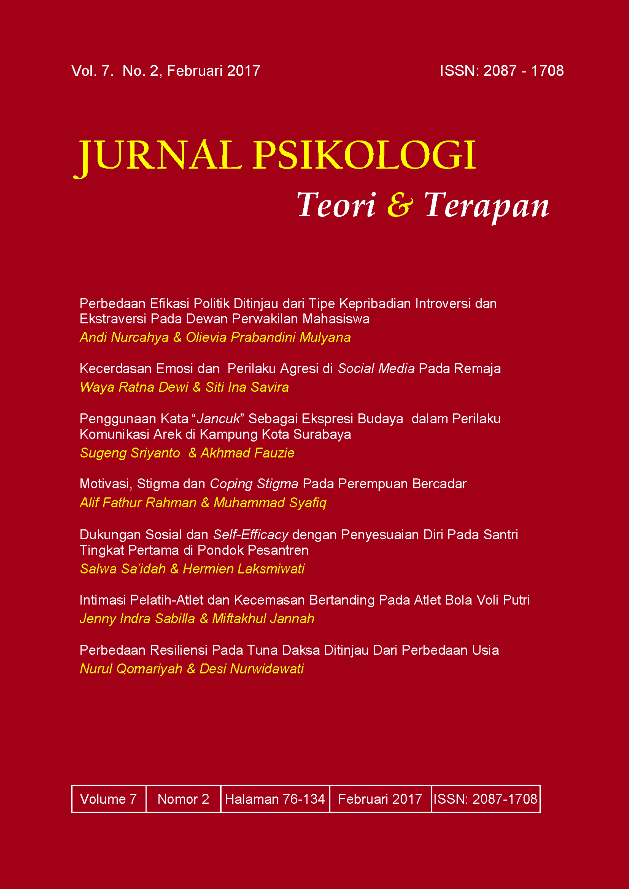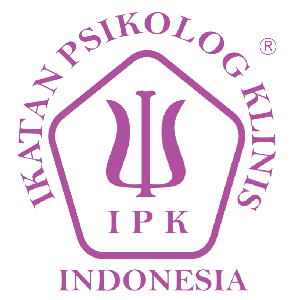Intimasi Pelatih-Atlet dan Kecemasan Bertanding Pada Atlet Bola Voli Putri
DOI:
https://doi.org/10.26740/jptt.v7n2.p123-129Keywords:
Kecemasan bertanding, intimasi, pelatih, atlet, bola voliAbstract
Coaches can recognize their athletes deeply by building intimacy. Intimacy leads to the disclosure of personal matters to other people. Athletes who have intimacy with their coaches will talk openly about themselves. By intimacy, coaches can appropriately provide load tasks according to the abilities of athletes and give assistances to the athletes during competition. This research aims to determine the correlation of anxiety to competition and intimacy of coach-athlete in volley ball athletes. This was a correlation quantitative methods with parametric data. 60 volley ball student club athletesin Universitas Negeri Surabaya (Unesa)were involved in this study. Two instruments used were anxiety to competition and coach-athlete intimacy scales. Data were analyzed using Pearsons product moment correlation. The results shows the signivicant value (p) of 0.000 (p < 0,05) which means the hypothesis of this study is accepted: there is significant correlation between athlete-coach intimacy and athletes anxiety to competition. The result also shows the correlation coefficient of -0,661 which indicates that the correlation is negative. It can be concluded from this result that athletes who have high coach-athlete intimacy will feel less anxious to competition.
Abstrak: Intimasi mengarah pada keterbukaan pribadi dengan orang lain, pelatih dapat mengenal atlet lebih dalam dan pelatih bisa dengan tepat memberikan beban tugas yang sesuai dengan kemampuan atletnya. Adanya intimasi dengan pelatih, membantu atlet menurunkan kecemasan bertanding. Penelitian ini bertujuan untuk menguji hubungan antara kecemasan bertanding dan intimasi pelatih-atlet pada atlet bola voli dengan menggunakan metode kuantitatif korelasional. Subjek penelitian adalah 60 orang mahasiswa UKM bolavoli Unesa. Instrumen yang digunakan adalah skala kecemasan bertanding dan skala intimasi pelatih-atlet. Analisis data yang digunakan dalam penelitian ini adalah korelasi pearson product moment. Hasil penelitian data menunjukkan nilai koefisien korelasi sebesar -0,661. Atlet yang memiliki intimasi pelatih-atlet akan merasa mendapat dukungan dari pelatihnya sehingga atlet merasa memiliki persepsi diri positif dan merasa nyaman.
References
Amir, N. (2004). Pengembangan Instrumen Kecemasan Olahraga. Anima, 20 (1), 55-69. (Online). Diakses pada 5 Februari 20151 dari: http://scholar. google.com/scholar?client=msopera-mobile&channel=related:vHzvEt X7O2y8.scholar.google.com.
Atwater, E. (1993). Psychology of Adjustment. (2nd Ed.). New Jersey: Prentice Hall, Inc.
Brehm, S. S., Miller, R. S., Perlman, D., & Campbell, S. M. (2002). Intimate Relationship. New York: McGraw-Hill Companies.
Cox, R.H. (2002). Sport Psychology: Concept and Application. Boston: McGraw-Hill.
Davies, D. (1989). Psychological Factor in Competitive Sport. Philadelphia: Falmer Press.
Gunarsa, S.D. (1996). Psikologi Olah Raga dan Praktek. Jakarta: PT BPK Gunung Mulia.
Gunarsa, S.D. (2000). Psikologi Olahraga dan Penyerapannya untuk Bulutangkis. Jakarta: PT BPK Gunung Mulia
Hartanti, Yuwanto, L., Pambudi, I., Zaenal, T., & Lasmono, H. K. (2004). Aspek Psikologis dan Pencapaian Prestasi Atlet Nasional Indonesia. Anima, 20 (1), 40-54. (Online). Diakses pada 5 februari 2016 dari: http://www.google.com/search?=daftar+pusaka+aspek+psikologi+dan+ pencapaian+prestasi+atlet+nasional+indonesia.
Lee, M. (1993). Coaching Children in Sport: Principle and Practice. London: E & FN Spon.
Pate, R. R., McClenaghan, B., & Rotella, R. (1993). Dasar-dasar Ilmiah Kepelatihan. (Penerjemah: Kasiyo Dwijowinoto). Semarang: IKIP Semarang.
Prager, K. J. (1995). The Psychology of Intimacy. New York: The Guilford Press.
Sadarjoen, S. S. (2005). Konflik Marital (Pemahaman Konsep, Aktual, dan Alternatif Solusinya). Bandung : Refika Aditama.
Satiadarma, M. P. (2000). Dasar-dasar Psikologi Olahraga. Jakarta: Pustaka Sinar Harapan.
Shadily, H., & Echols, S. M. (1990). Kamus Inggris Indonesia. Jakarta: PT. Gramedia.
Singer, R. N., Hausenblas, H. A., & Janelle, C. M. (2001). Handbook of Sport Psychology. New York: John Wiley & Sons, Inc.
Steinberg, L. (1993). Adolescence. New York: McGraw-Hill, Inc.
Sudradjat, N. W. (1995). Kecemasan Bertanding serta Motif Keberhasilan dan Keterkaitannya dengan Prestasi Olahraga Perorangan dalam Pertandingan untuk Kejuaraan. Jurnal Psikologi Indonesia, 1, 7-13. (Online). Diakses pada 5 Februari 2016 dari: http://www.google.com/m?q=sudrajat%kecemasan+bertanding+serta+motif+keberhasilan+dan+keterkaitannya+dengan+prestasi+olahraga+perorangan+dalam+pertandingan+untuk+kejuaraan
Sugiyono. (2010). Metode Penelitian Kuantitatif, Kualitatif & RND. Bandung: Alfabeta.
Downloads
Published
How to Cite
Issue
Section
License
Authors who publish in this journal agree to the following terms:
Copyright in any article is held by the author.
The author grants the journal, publication rights with the work simultaneously licensed under a Creative Commons Attribution License that allows others to share the work with an acknowledgment of the work's authorship and initial publication in this journal.
Authors may enter into separate, additional contractual arrangements for the non-exclusive distribution of the journal's published version of the work (e.g., posting it to an institutional repository or publishing it in a book), with an acknowledgment of its initial publication in this journal.
Authors are permitted and encouraged to post their work online (e.g., in an institutional repository or on their website) prior to and during the submission process, as this can lead to productive exchanges, as well as earlier and greater citation of published work.
 Abstract views: 2066
,
Abstract views: 2066
, PDF Downloads: 1367
PDF Downloads: 1367


















